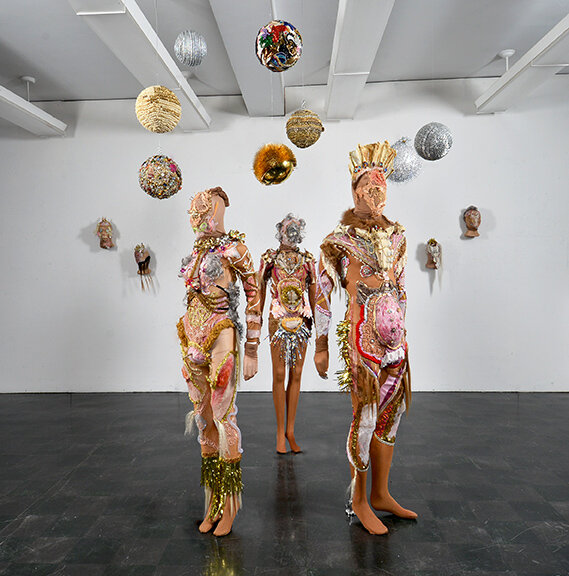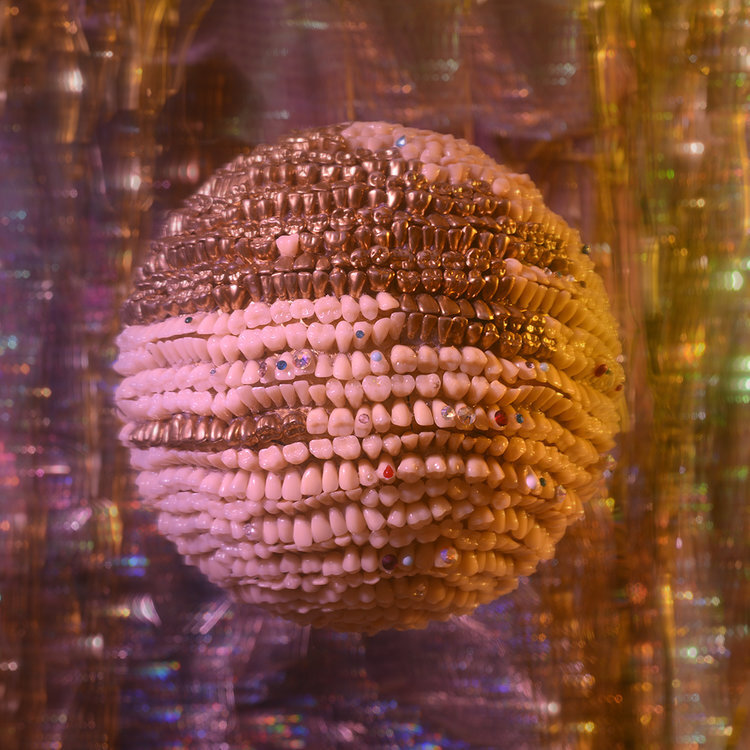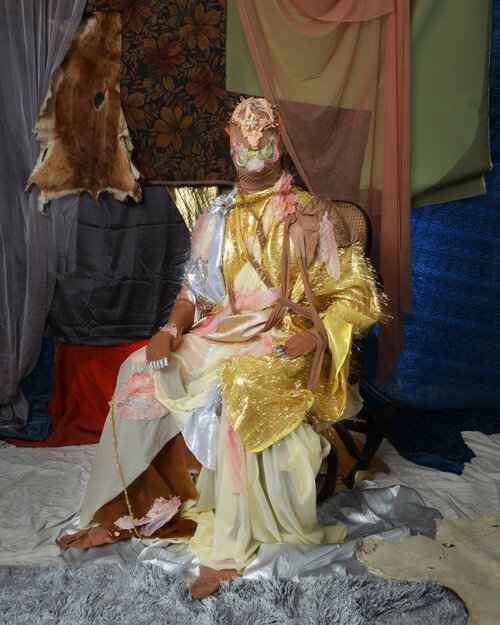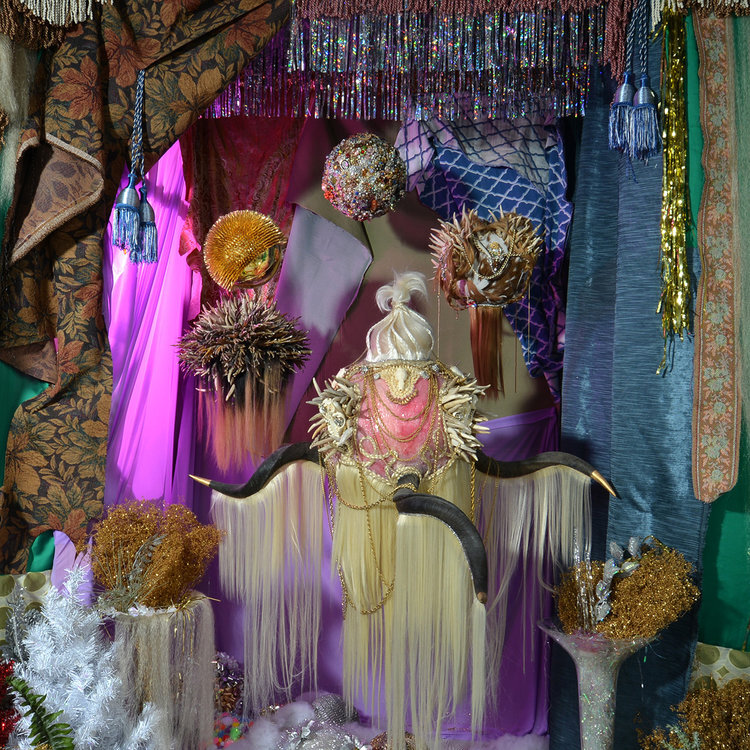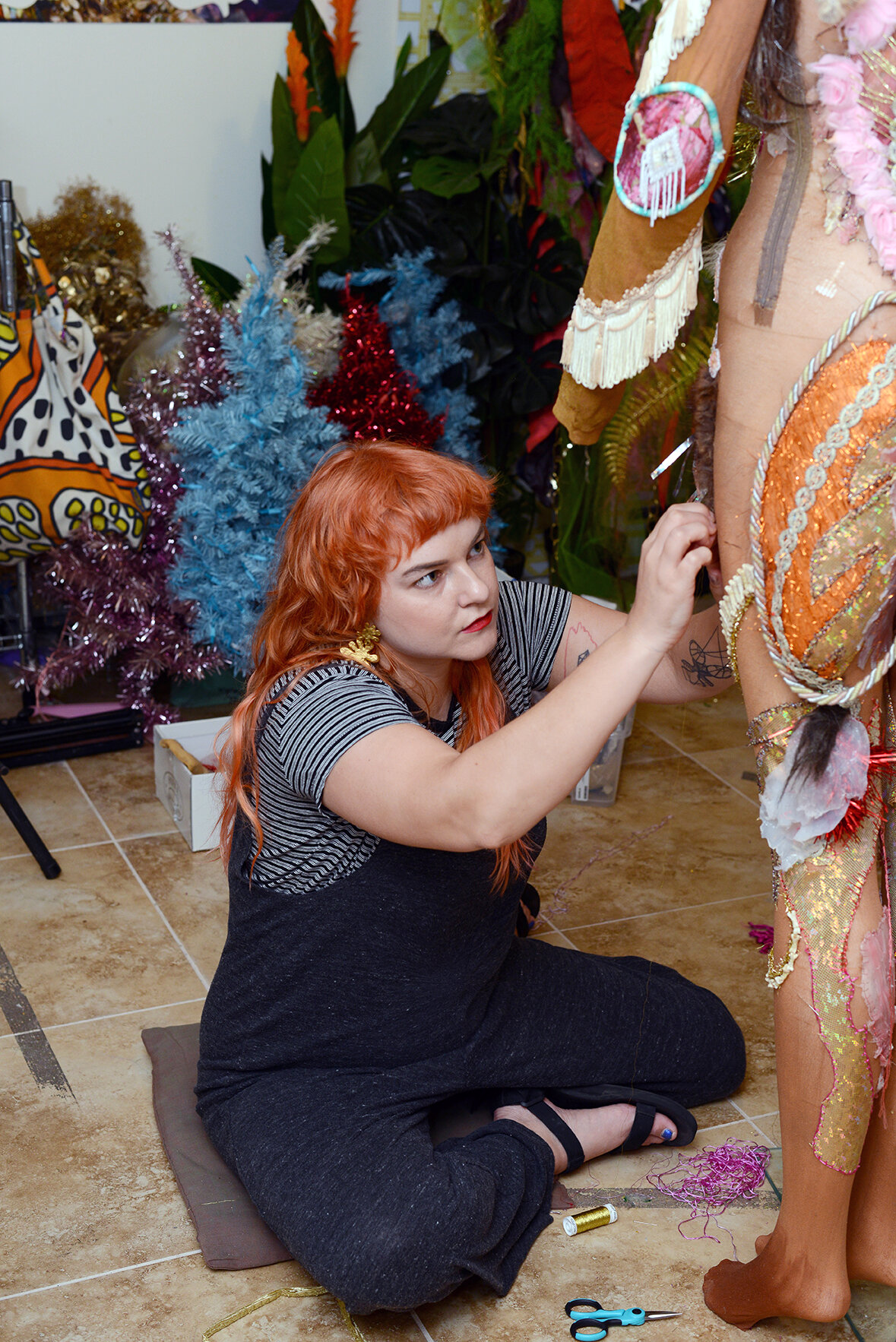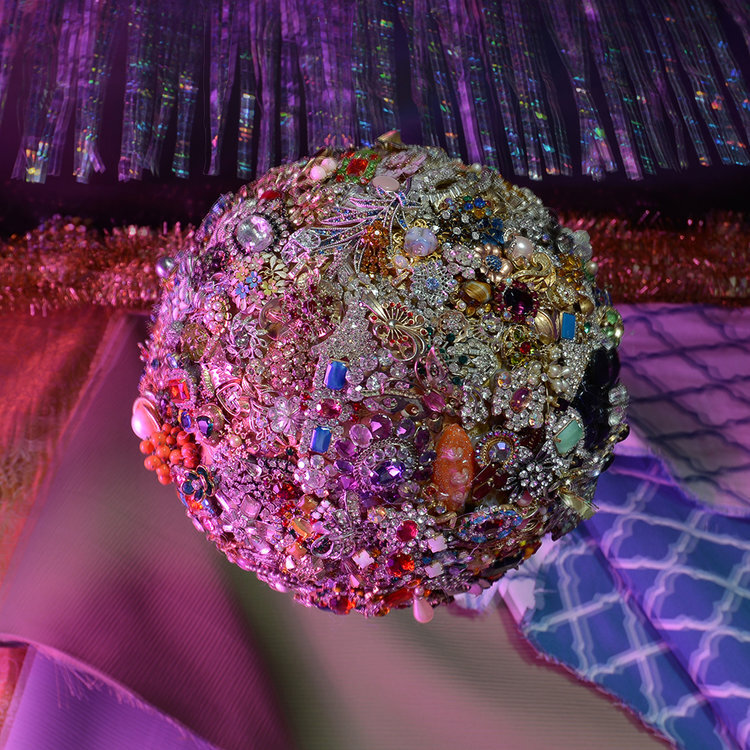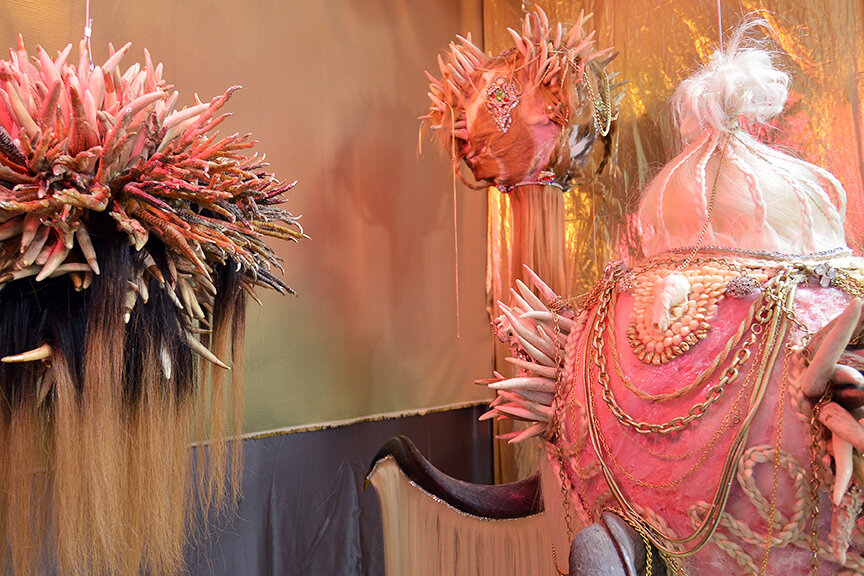Katharine ryals
Façade I (2020)
Nylon, latex, trims, vintage jewelry, rhinestones, embroidery.
18x6x8 (inches)
For purchase inquiries please contact the artist at kryals20@live.com
To learn more about the artist visit www.katryals.com
recent links
From "7 Minutes with Naomi" with curator Naomi Lev:
https://www.youtube.com/watch?v=wxSbKVhguSg
From "Virtual Open Studios" with the Wassaic Project:
https://www.instagram.com/tv/CDznsafFYC5/?utm_source=ig_web_copy_link
Excerpt from walkthrough with Virtual Studio Visit Network:
https://www.instagram.com/p/CAdmz0lFK2n/?utm_source=ig_web_copy_link
Horror Vacui by Katharine Ryals. All rights reserved.
Orbs and Regalia by Katharine Ryals. All rights reserved.
Orb V by Katharine Ryals. All Rights Reserved
Orb II by Katharine Ryals. All Rights Reserved.
Icon II by Katharine Ryals. All rights reserved.
Shrine by Katharine Ryals. All rights reserved.
Katharine Ryals
Love the Sin You’re In - Katharine Ryals. All rights reserved.
Orb I by Katharine Ryals. All Rights Reserved.
Installation by Katharine Ryals. All rights reserved.
Work in Progress by Katharine Ryals
Artist’s statement
In my practice, I examine the enchantment of ornamentation and special effects, seeking to understand the relationship between power and illusion. How does this relationship function on an individual level as well as in large encompassing systems such as capitalist economies and organized religion? Using the tension between the natural and artificial, the sacred and profane, and the luxurious and kitschy, I investigate our human will to power, our insistence upon hierarchy, our fear of mortality. Through my masks, or "skins,” I create artifacts of speculative societies infused with Catholic, Sci- fi, Baroque, and Victorian influences as well as elements of a glittery pop-culture kitsch and neo-shamanistic imagery.
These “skins” could also be thought of as “consumer cannibals.” Instead of "you are what you eat,” I think in terms of “you are what you consume.” The masks invoke a sense of power, pageantry, carnivalesque humor, and decadence. The work holds the illusion of luxury, yet it is created from mostly mass-produced, cheap, lowbrow, gaudy, disposable materials. They are largely made up of durable synthetic materials, yet they appear to be in a state of decay, representing consumerist ruins or contemporary relics.
About the Artist
Originally from Little Rock, Arkansas, Kat Ryals is a Brooklyn-based artist, curator, and photographer. She holds a BFA in Photography from Savannah College of Art and Design and an MFA in Photography as well as an Advanced Certificate in Museum Education from Brooklyn College. Ryals has exhibited
nationally, including in a solo booth at SpringBreak Art Show in 2020, and in recent group exhibitions with the Holocenter on Governor’s Island, Temporary Storage Gallery at Brooklyn Fireproof, the Wassaic Project, and Ortega Y Gasset Projects. She has completed residencies at the Vermont Studio Center, the Wassaic Project, and ChaNorth.
Ms. Ryals is cofounder of the arts platform, Paradice Palase, based out of Bushwick, Brooklyn. In recent years, she has been pursuing an interdisciplinary approach to her artistic practice, creating lens-based and digital works, 3D objects, wearables, and installations.
Katharine Ryals was our featured artist for December 21-27, 2020. In this interview she discusses her work in greater depth. We will feature a new artist of the Babelmasks Ad-Hoc Collective each week.
10 questions
1) The scope and range of your installation work is quite breathtaking! How do you design the interiors and environments of these installations to make sure everything appears in the space at the scale you intend? Do you fully design the scene, or do you start with a few anchoring elements and develop secondary elements to answer that main statement?
Typically, I have a loose vision for what I want to create, and from there create a basic layout as a guide. Usually, the layout is just the arrangement of those anchoring elements you mentioned, such as larger sculptures and completed artworks. From there, once I’m actively setting up the space, I fill in the details surrounding these elements, usually dressing the scene with found fabrics, objects, and other decorations. Scale is definitely important to me, because I want installations to come across as being potentially a real-life interior of some esoteric culture. So, they are preferably experienced as complete rooms, or wholly intact interior spaces. My installations often serve as backdrops for photo shoots as well.
2) You mention in your catalog statement that “These ‘skins’ could also be thought of as “consumer cannibals.” Instead of ‘you are what you eat’ I think in terms of ‘you are what you consume.” The masks invoke a sense of power, pageantry, carnival humor, and decadence. The work holds the illusion of luxury, yet it is created from . . . “cheap, lowbrow, gaudy, disposable materials.” I am wondering if you can unpack this a little. This statement belies the dazzling beauty of the image the “skin” creates – on closer inspection the seemingly precious is revealed to be made of the cheapest items. I imagine these as a kind of memento mori, an underlying sense that all is vanity – the encrustation of glitter is so thick and textured it almost negates the idea that there is any actual life inside the skin at all – or perhaps the life one might be in danger of living if they only focused on exterior concerns. Yet the work is legitimately lovely and fabulous and inspires desire in the viewer – “I would love to wear that/be that/exist there.” Can you clarify your thoughts about the mechanics of how these contrasts work? Do you think of these “skins” in a different light?
I think of these “skins” relating more closely to the second description – that our lives are made up of constant consumption of materials and production of waste, a lot of it fueled by unnecessary desires. My work is driven by the exploration of the human condition and trying to understand the universalities of why we are the way we are.
My research is anthropological in a sense, as I try to understand what drives our behavior and the core truths about humanity. Maybe there is no critique of our wasteful consumption to be had, if it’s a core part of our nature. But maybe it’s not a core part of who we are, and we’ve gotten off course.
How did that happen? Why did that happen? What should we do to self-correct? So of course, I tend to focus on examining desire, fear, hierarchy, value, spirituality, power, and ornamentation. This biological cocktail of drives and attributes seem necessary for our ability to survive. Or at least allows us to compete with each other for survival, which in the end, may not really be necessary.
I think that is why death is so present in my work – in imagery that also excites us and fuels us with a desire to indulge in living. It’s looking at feelings of desire, power, and indulgence as connected to a rejection or fear of death. And I feel that our underlying fear of death is the source of a lot of our negligence and self-created problems as a species.
3) You have a knack for fooling the eye using semiotics which use a broad image to suggest one set of meanings and the particular image to suggest another. One that is particularly striking is a mirror ball that on closer inspection is composed of gelatin capsules holding glitter – so we are first presented with a signifier for party-time and drawn closer, only to be presented with a contrasting signifier of illness/health via medication – and then presented with a third signifier in that the capsules are filled with glitter, which invokes images of the party life – in this example, you take us three layers deep from one extreme to the other. Is this another form of vanitas? Do you often layer opposing meanings by way of image and materials in this way?
For this piece, I actually did not intend to layer contrasting meanings. Each disco ball in the series, titled discocosmos, replaces traditional mirror tiles with embellishments that reflect contemporary culture and its associated desires. While most of the materials used for this series reference altering our outside physicality, the pills used here suggest the manipulation of our interior world as well, with the glittering pills alluding to indulgent “designer drugs”. I think with this particular series, the double meaning comes with the concept of the series itself. The orb shape references two distinct forms of worship – that of ancient cosmological bodies or of idolization of club culture. I would say I do layer opposing meanings quite often, as many artists do, in order to offer introspection on what is largely culturally accepted and introduce new ideas to old concepts.
4) Your environments and their inhabitants such as the one presented here display a mélange of luscious antique fabrics and animal hides – the effect of the composition is reminiscent of the royal portraits of the Baroque era – for example Velasquez. The image oscillates between tribal royalty and royal tribalistic hierarchies and infuses the figure with an undeniable air of nobility. Can you say more about your intention in setting up this oscillation between prehistoric existence and royal decadence of the 17th and 18th centuries?
I often blend the profane with the sacred – with titles and imagery alluding to the spiritual or religious, yet the materials and forms are largely secular, “worldly”, and often grotesque. I look to the past and how spirituality (and notions of power) has guided so much of our understanding of the world and accompanying values and aesthetics across cultures and time. We’ve entered an age where spirituality seems to be vacant – but perhaps its only mutated. There seems to be some sort of secular shamanism that has evolved in the Western world – an occurrence brought forth from the shift away from religious states to late-stage capitalism. I think that’s one question out of many that I’m exploring in my work - is spirituality necessary? Are we better off, or doomed, without it? Does it lurk beneath any type of system of belief, whether highly visible or extremely obscured?
5) You have created multiple worlds that seem to blur into each other and yet are quite at ease with each other. Royal drawing rooms phase into undersea palaces and glittering ballrooms. Can you say a little more about this approach?
Most of my work is tied together by the exploration of the same core themes and I’m also conscious of this as I develop new work. My works live independently on their own as individual artworks or series, but they can also seamlessly overlap to become part of a cohesive world or narrative that I am continuously crafting. I build my practice as if I’m playing with a doll house of individual rooms with their own look and feel that are all part of the same house, and I can easily switch the furniture around to create new arrangements.
6) These appear to be very delicate works – are they in fact quite durable to handle? How do you store these works? Are installations kept ready to redeploy, or are they site-specific works whose basic materials can be turned into something else later?
Yes, and no. For the masks and bodysuits, I use a base material of nylon, which itself is pretty durable because it is stretchy and made to be stretched over and over again. Silicone and thread are also very durable, so I don’t usually run into problems there. Sometimes, the thread unravels over time from wear and tear but it’s easy to mend. It’s the attached embellishments that are quite delicate and the natural materials that are slowly decaying, such as rubber latex.
There’s a lot of upkeep that goes into latex in particular, as it tarnishes over time; it can become sticky, or it can disintegrate. So I occasionally dust powder over the pieces of latex, and I do paint latex so discoloration is not an issue. Most often, things get pulled off in transportation; then the work is reinforced and mended on site. It’s a challenge.
As I go on creating these suits and masks, I’ve learned to consider new methods of attaching and reinforcing embellishments when I find a previous method has caused too many issues. The same goes for properly packing the work for storage and transportation.
Installation materials pretty much stay in storage as elements that come together for site-specific pieces, then are dismantled and stored for future use. There is some breakage for materials that I use repeatedly, so occasionally I have to invest in new materials.
7) You mention in your statement that you investigate “our insistence on hierarchy.” Can you say a little more about these investigations? Do you think that hierarchy is hard-wired into our primate biology? Is a large social system without hierarchy a dream come true or a nightmare in your thoughts? Also, do you see a trend happening now where hierarchy as a concept is evolving further to one direction or the other?
I’ve been thinking about hierarchy a lot this year and wondering that question. Is it hard-wired into our primate biology? I’m not sure. If we look at history for at least 2000 years, it seems like it is. But in contemporary times, I believe we are moving away from it and more and more.
We are adopting the notion of operating on a spectrum. Instead of processing our world in top to bottom systems, we’re starting to see things on equal, but oscillating, lines. I’m truly excited about this stage of our social and cultural evolution.
However,our world is also growing increasingly complex to the point of being nightmarish. The hardships of so many contradictions and confusions arise in that case. I often get overwhelmed and exhausted by that complexity and return to this place of wanting to shed everything and live as simply as possible.
We associate complexity with stress and simplicity with ease of mind. However, once we find a way to be ease with unlimited possibilities, these associations may change. To me, hierarchy creates a comfort zone in the same way that binaries do – it simplifies everything for us. But it creates oppressive inequities which are not necessary to navigate our world, and I think we are starting to evolve past them as structures for understanding.
8) How do you choose materials for your work? Are these found objects or items that you purchase or that friends or businesses donate? Are there materials that you specifically decline to use, for whatever reason?
I choose materials based on how organic or how artificial they are. That which organically exists without our involvement, that naturally decays on its own, that is already dead, signifies truth. And that which is manufactured, that doesn’t die, that is a mimicry of something else, signifies cheating. I also look for materials that offer maximum dazzle in harmony with maximum cheapness. I’m interested in evoking simultaneous shame and desire in the viewer.
I source my materials from a variety of places. Family and friends send me bones and organic materials from their farms, or they send me bags of costume jewelry found in an old drawer.
Sometimes I want something in particular or need something unusual, and I’ll find that online. Other times, I mine things from junk and thrift stores. In the past, I’ve gotten the bulk of my installation materials through recycling programs such as Materials for the Arts in NYC. So, some are found, some are purchased old or new, and some are donated or obtained for free.
9) You have completed several residencies, including the Vermont Studio Center. Can you talk a little bit about what impact these residencies had on your practice and on your work?
Sure! They’ve all impacted my work in different ways and catered to different aspects of my career growth. Some residencies, such as Vermont Studio Center, were more focused on peer networking, and others were more academic- and research-based. I have met some amazing artists, found new friends, and made important professional connections from my experiences, and I am grateful for that.
At the moment I’m most interested in residencies geared toward professional development (like learning a new skill): those that are less social and more process-oriented. Arquetopia was an experienced-based residency rather than production-focused. I was there with just three other artists, which was nice because it was so intimate. That residency has proved to be so valuable to me. I didn’t produce much while I was there - I just learned a great deal. Arquetopia assigned us lengthy readings, which I enjoyed. I spent most nights reading and developing ideas within my own practice. I went to weekly classes to learn embroidery with the incredible Estela Antonio, a local Zapotec artisan and fashion designer there. We went on field trips to museums, farms, historic sites, etc. And we were immersed in and educated about a culture different from our own.
10) What advice would you give to a person who has decided to pursue a career in fine art? What do you wish you had known when you started out?
My advice is to take marketing and business classes! And network. I know this is really hard for introverts but it is really how opportunities arise. The focus within academia is on building technical skills and understanding criticism, theory, and history, which is important, but they often don’t focus enough on learning practical skills for success in the art market.
You can be an excellent painter, but you can’t build a career by being alone in your studio. I took two business classes in undergrad and one in grad school, and they simply were not enough. I wish I had taken marketing classes when I was in school.
Art schools should offer business classes that actually do equip students to build careers as independent artists - classes that teach how to run a studio, how to build an brand, how to price and find a market for your work, methods for building a client base, and so on.
As a small business owner, I’ve been learning how to properly run a small business over the last few years and everything I’m learning applies to artists as well, who are themselves small business owners. I’m starting to apply what business skills I’ve learned to my own studio practice.



